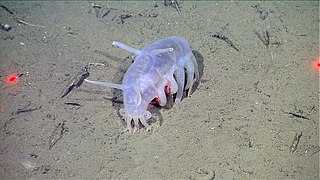Beaked whales are a group of cetaceans noted as being one of the least known groups of mammals because of their deep-sea habitat and apparent low abundance. Only three or four of the 22 species are reasonably well-known. Baird's beaked whales and Cuvier's beaked whales were subject to commercial exploitation, off the coast of Japan, while the northern bottlenose whale was extensively hunted in the northern part of the North Atlantic late in the 19th and early 20th centuries.

Sea cucumbers are echinoderms from the class Holothuroidea. They are marine animals with a leathery skin and an elongated body containing a single, branched gonad. Sea cucumbers are found on the sea floor worldwide. The number of holothurian species worldwide is about 1,717 with the greatest number being in the Asia Pacific region. Many of these are gathered for human consumption and some species are cultivated in aquaculture systems. The harvested product is variously referred to as trepang, namako, bêche-de-mer or balate. Sea cucumbers serve a useful role in the marine ecosystem as they help recycle nutrients, breaking down detritus and other organic matter after which bacteria can continue the degradation process.

Velodona togata is a species of octopus in the monotypic genus Velodona. First described by Carl Chun in 1915, with a second subspecies discovered by Guy Coburn Robson in 1924, it was named for the distinctive membranes on its arms.

Scotoplanes is a genus of deep-sea sea cucumbers of the family Elpidiidae. Its species are commonly known as sea pigs.

Enypniastes is a genus of deep-sea sea cucumber. It is monotypic, being represented by the single species Enypniastes eximia. Due to its unique appearance, the species has been dubbed the headless chicken fish, headless chicken monster, and the Spanish dancer. It is also known as the swimming sea cucumber, and some are called the pink see-through fantasia.

Elasipodida is an order of sea cucumbers. They have numerous appendages, including conical papillae and leaf-like tentacles. Although many species are benthic, a number are pelagic, and may have their appendages modified to form sails or fins. Most members of the order inhabit deep-sea environments, such as the species of the genus Enypniastes.

Psychropotes is a genus of sea cucumbers in the family Psychropotidae. The members of this genus possess the ability to swim, although this is only facultative.

Elpidiidae is a family of deep-sea sea cucumbers.
Elpidia minutissima is a species of deep-sea swimming sea cucumber in the family Elpidiidae. It is a detritivore and is found in the northern Pacific Ocean.
Peniagone is a genus of deep-sea sea cucumbers in the family Elpidiidae. Peniagone wyvillii is the type species.
Peniagone vitrea is a species of deep-sea swimming sea cucumber in the family Elpidiidae. It is a detritivore and is found in the northern Pacific Ocean at abyssal depths. It was first described by the Swedish zoologist Hjalmar Théel in 1879, being one of the many deep sea animals discovered during the Challenger expedition of 1872–1876.

Johan Hjalmar Théel was a Swedish zoologist and university professor.
Ellipinion is a genus of deep-sea sea cucumbers in the family Elpidiidae. It was first described by the French marine biologist Edgard Hérouard in 1923.

Elpidia glacialis is a species of sea cucumber in the family Elpidiidae. It is found at abyssal depths in the Arctic Ocean, the Barents Sea, the Kara Sea and the north Atlantic Ocean. It was first described in 1876 by the Swedish zoologist Johan Hjalmar Théel after he had collected specimens while accompanying the explorer Adolf Erik Nordenskiöld on an expedition attempting to find the Northeast Passage.

Myriotrochidae is a family of sea cucumbers.

Myriotrochus is a genus of sea cucumbers. The following species are recognised in the genus Myriotrochus:

Scotoplanes globosa, commonly known as the sea pig, is a species of sea cucumber that lives in the deep sea. It was first described by Hjalmar Théel, a Swedish scientist. Scotoplanes globosa, along with numerous other sea cucumbers were discovered by Théel during an expedition on HMS Challenger between the years of 1873-1876. Scotoplanes globosa was officially described in 1882, 6 to 9 years after its first sighting. Scotoplanes globosa is most closely related to the genus Peniagone.

Psychropotidae is a family of deep-sea swimming sea cucumbers. The geographic range of some psychropotids is very extensive at abyssal depths, whereas other species are found within more restricted ranges.

Benthodytes is a genus of sea cucumbers in the family Psychropotidae.
Psycheotrephes is a genus of sea cucumbers in the family Psychropotidae.











